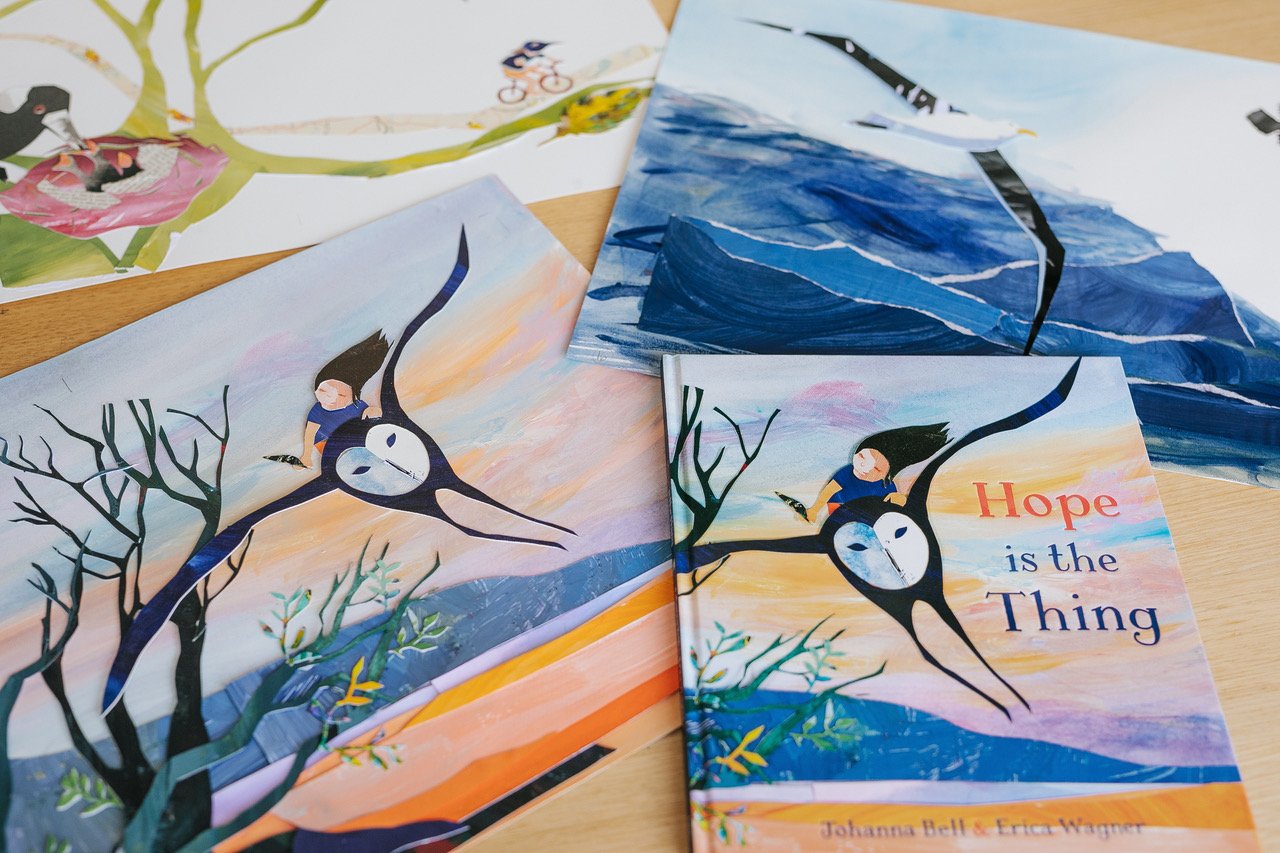Hope is the thing
A highly original, beautiful and deeply meaningful picture book that sees the marvellous and inspiring world of birds through the eyes of a child and celebrates birds' adaptability and ingenuity.
Hope is a kookaburra singing the sun
Hope is the emu learning to run ...
Sparked by the Emily Dickinson poem 'Hope is the thing with feathers', this lyrical text accompanied by glorious mixed media collages reflects and celebrates the diversity and wonder of birds.
Let your imagination soar in this joyful ode to the world of birds and the healing power of nature.
Credits
Illustrations : Erica Wagner
Publisher : Allen & Unwin
Design : Jo Hunt
Released : 2023
Awards
2024 CBCA Book of the Year, Award for New Illustrator
2024 Environment Award for Children's Literature
Praise
‘A stunning book … that celebrates the joy and beauty of small, everyday moments … truly magical.’ (Readings)
‘A great book for all ages … calming … magical … and filled with joy.’ (Ashleigh Meikle)
Resources
Allen & Unwin have created teaching notes for primary school teachers.
Author’s note
When I was little, my grandmother used to take me to Centennial Park to feed the ‘bords’ – mostly ducks, coots and geese and if we were lucky, black swans. I remember squealing as they tried to steal bread from my fingers. And a few years later, while camping near Jervis Bay, I was overjoyed when a king parrot landed on my outstretched palm and ate seed straight from my palm. Then there was the baby kookaburra that fell from its nest. I lifted him up in a tea towel and placed him on top of the hills hoist so his parents could help him back to his nest. And the mischievous cockies that chewed big chunks out of my dad’s deck (much to his horror), the pelicans who patrolled for scraps down at the boat ramp and the ever-present chorus of magpies, butcher birds, honeyeaters, lorikeets, koels, wattlebirds and currawongs serenading me through childhood. It felt as if birds followed me everywhere and eventually, I started following them.
I can’t remember when I got my first pair of binoculars but I do remember going birdwatching with my grandfather. He was quite elderly at the time and couldn’t walk very far. We sat quietly on a granite boulder and looked out into the scrubby bush. My view was filled with stringy barks, squiggly gums and banksia. At first I couldn’t see any birds but then I noticed the flit of a tiny treecreeper. I’d never seen before and we sat for half an hour watching him hopping up and down tree trunks, flipping the bark and catching the tiny grubs beneath. It felt like time stopped that day and the rest of the world shrunk back; it was just me and the bush and the bird.
When I moved to Darwin in 2009, one of the things that amazed me was the density and diversity of birdlife. It’s not unusual to go for a walk and see 30+ species. Some of my favourites are stone bush curlew with its eerie cry, the tiny red-headed honeyeater darting among the flowering gums, double-barred finch with his heart-shaped face, the kites whistling above, the majestic red-tailed black cockatoo and the ibis rifling through every bin.
A few years ago, I started to notice that Darwin’s birds were disappearing. The sacred kingfisher, which I used to see in the most built up areas, had vanished. And the Eastern curlew, which used to stop here every year on its way to Siberia, was listed as Australia’s fastest disappearing shorebird. It made me sad to think that the birds were vanishing and no one seemed to notice.
In 2019, when bushfires engulfed Eastern Australia, I was horrified by the news that between one and three billion mammals, birds, reptiles and fogs had perished. I felt sick and then I felt a deep grief, which became a sense of hopelessness.
Around that time, I rediscovered Emily Dickinson’s poem Hope is the thing with feathers and it made me wonder ‘If hope really is the thing with feathers, what does that actually look like? I started playing with words and came out with a pretty clunky poem which I showed to my friend Erica Wagner. We were running a story camp at the time and we decided to use the process that we’d developed for the writers and artists we were working with on ourselves. We called it ‘what iffing’ because it involved developing ideas by asking each other lots of questions that start with ‘what if’. What if you expand the poem to include birds from all over Australia? What if we switch the last two lines around? What if we start the story with a little girl who’s stuck at home? What if you rip up some old maps and use them in the collaged illustrations?
When Erica returned to Melbourne we kept ‘what iffing’ via zoom. We would work ‘shoulder to shoulder’– me on my words and Erica on her beautiful collages and paintings. Then we’d share what we’d created and respond to each other’s work with more questions. Back and forth the creations flew, travelling thousands of kilometres, like migratory birds, until eventually, we had created Hope is the Thing.
We made this book because we wanted to remind ourselves about the importance of paying attention to the natural world and the transformative power of art making. In our creative practice, we’ve experienced the way that making art generates shifts – both in us and in the people around us – and we hope that in reading this book, your way of seeing birds shifts too.
